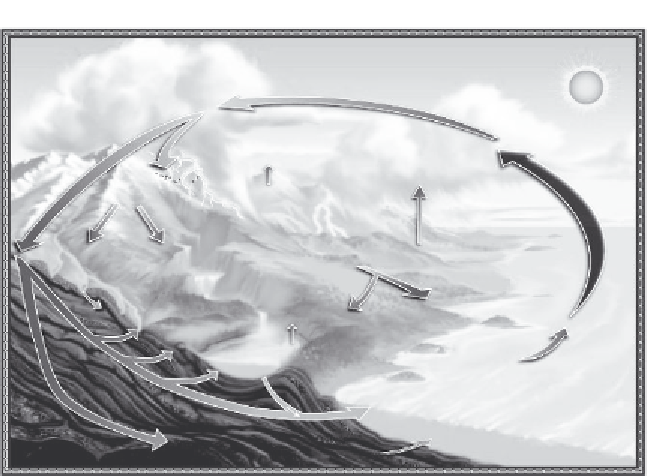Environmental Engineering Reference
In-Depth Information
Water storage in
ice and snow
Water storage in the atmosphere
Condensation
Sublimation
Evapotranspiration
Precipitation
Evaporation
Snowmelt runoff
to streams
Surface runoff
Streamflow
Evaporation
Infiltration
Spring
Freshwater
storage
Wate r s to ra ge
in oceans
Groundwater storage
FIGURE 2.1 Earth's Water Cycle
Source:
U.S. Geological Survey, modified from USGS illustration by John M. Evans, “The Water
Cycle,” at http://ga.water.usgs.gov/edu/watercyclesummary.html.
and gravel underneath us. It can be shallow, meaning it's relatively
close to the surface and routinely replenishes itself with surface
water runoff. That's a
renewable
aquifer. Other aquifers are deeper
and don't refi ll or recharge as easily. Sometimes they may not
replenish themselves in a lifetime or beyond. These are often called
prehistoric
aquifers. The last time many of these aquifers were fully
recharged or fi lled, says Hightower, was in the Ice Age ten thousand
years ago, when tons of ice melted all at once, saturating the ground
down to the aquifers. “If we use that water up—and we are—it's not
going to fully replenish itself until the next Ice Age,” he adds.
The High Plains connection.
One such prehistoric aquifer is the
High Plains aquifer, which includes the Ogallala. The High Plains
covers 174,000 square miles in parts of Colorado, Kansas, Nebraska,
New Mexico, Oklahoma, South Dakota, Texas, and Wyoming and
is the largest aquifer in the United States.
22
Data from the USGS
and other organizations—public and private—agree that parts of




























